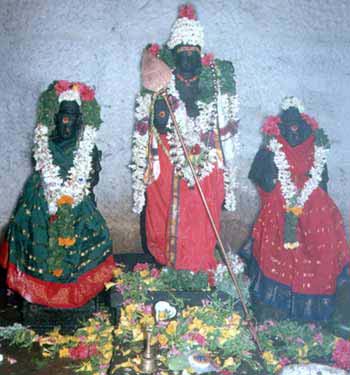Verse 62
பாரப்பா
பஞ்ச சக்தி தீட்சையாலே
பரலோக
முழுவதுமே தனதாய்ப் போகும்
ஆரப்பா
அஷ்டகர்ம வாலையாலே
யாகாதி
யொன்றுக்கு வயது நூறு
நேரப்பா
யாகாதி செய்யவுந்தான்
நிலைதவறா
திருந்துமனம் நிறுத்த வேணும்
பேரப்பா
இப்படியே பேருபெற்றேன்
பேசாத
மவுனத்திற் கூடினேனே
Translation:
See son, due to Pancha Sakthi Deeksha
The entire world of param will become one’s own
Rest son, due to the Ashta karma vaalai
Lifespan will be hundred years
It is proper son, to perform yaga and others
One should remain firmly in one’s state and stop the mind
See son, in this fashion I attained glory
I joined the unspeaking silence.
Commentary:
The Pancha Sakthi or five sakthi are Chith Sakthi,
Parasakthi, Iccha sakthi, Jnana Sakthi and Kriya Sakthi. Chith Sakthi is the awareness of the Supreme
Being, Parasakthi is the active form of Param.
Siva and Sakthi transform into Jnana sakthi and Kriya Sakthi, the wisdom
about the state of Divine with a form and its power to move/function. Iccha Sakthi is the will of the Divine which
manifests as bindu, the primordial form for manifestion. This bindu is made of suddha maya. The five Sakthi are the causes for
manifestion. Hence, having their deeksha will grant the entire manifested
universe.
Ashta karma are the eight acts of sthambanam, maaranam,
mohanam, vidveshanam, bedhanam, ucchadanam, aakarshanam and aakrooshanam. These powers are generally associated with
black magic but that is not their original intent. Vasiyam is attracting all
the knowledge, devas, munis, animals, spirits, desires and worldly life towards
oneself.
Mohanam is making all the life forms and elements of
nature being attracted towards oneself.
Sthambanam is making all the elements stop their action upon one’s
will. Ucchadanam is removal of all diseases,
evil magical effects. Vidveshanam is controlling creation. Whatever the yogin touches will multiply ten
times. Maaranam is bring about
death. It is death of diseases and other
enemies for one’s spiritual attainment. If bedhanam is attained all the
diseases will be removed if the yogin offers anyone vibhuti. Agatthiyar mentions that Ashta Ganapathi are
responsible for these eight actions.
A yogin who has all the above actions under control will
live for hundred years. His mind will be
under control and performance of yaga will become easy.
பஞ்ச
சக்தி என்பவை சித் சக்தி, பரா சக்தி, இச்சா சக்தி, ஞான சக்தி மற்றும் கிரியா சக்தி
என்ற ஐந்து சக்திகளும் ஆகும். சித் சக்தி
என்பது பர சிவனின் தன்னை அறியும் உணர்வு.
ஆதி சக்தி உலகம் வெளிப்படக் காரணமாக இருக்கும் சக்தி. சிவனும் சக்தியும் வெளிப்பட்டவுடன் அவர்கள்
வெளிப்படுத்துவது ஞான சக்தி மற்றும் கிரியா சக்தி. அவர்களது விருப்பம் அல்லது சங்கல்பம் இச்சா
சக்தி. இவ்வாறு பஞ்ச சக்தி தீட்சை பர
உலகை- பரம் படைத்த உலகை, பரத்தின் உலகை ஒரு யோகிக்குப் பெற்றுத் தரும்.
அஷ்ட
கர்மா என்பவை வசியம், மோகனம், ஸ்தம்பனம், வித்வேஷணம், மாரணம், பேதனம் என்ற எட்டு
செயல்களாகும். இந்த செயல்கள் பொதுவாக
பிறருக்கு துன்பம் விளைவிக்கவே பயன்படுவதாக ஒரு எண்ணம் நிலவுகிறது. அவற்றின் உண்மைப் பொருளை அகத்தியர் இவ்வாறு
விளக்குகிறார். வசியம் என்பது எல்லா
சாஸ்திரங்கள், வேதங்கள் ஆகியவற்றையும் தேவர்கள், முனிவர்கள், விலங்குகள், பறவைகள்
மற்றும் ஆவிகளைத் தன்னை நோக்கி வசீகரிப்பது.
மோகனம் என்பது பஞ்ச பூதங்களைத் தன்னிடம் மயங்கச் செய்வது. ஸ்தம்பனம் என்பது பஞ்ச பூதங்களை செயலிழக்கச்
செய்வது. உச்சாடணம் எல்லா நோய்களையும் செய்வினைகளையும் விலக்குவது. வித்வேஷணம்- இதைப் பெற்ற யோகி தொட்டதெல்லாம்
பத்துமடங்காகும். மாரணம் என்பது பிறரை
மரணமடையச் செய்வது மட்டுமல்ல எல்லா வியாதிகளையும், ஆத்ம வளர்ச்சிக்கு விரோதிகளாக
இருப்பவற்றை மரிக்கச் செய்வது. பேதனம் சக்தியைப்
பெற்ற யோகி ஒருவருக்கு விபூதியைக் கொடுத்தால் அவருக்கு எதிரியாக இருப்பவை அனைத்தும்
விலகி ஓடும். இந்த எட்டு கர்மாக்களையும்
அருளுவது அஷ்ட கணபதிகள் என்று அகத்தியர் கூறுகிறார். இந்த சித்திகளைப் பெற்ற யோகி
நூறு வருடங்கள் வாழ்வார். யாகம் செய்வதற்குத்
தேவையான மனக்கட்டுப்பாடு அவருக்கு வாய்க்கும் என்று சுப்பிரமணியர் கூறுகிறார்.
